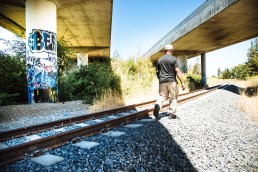As COTS’ CEO, each month I take a moment to consider what I want our community to know about our organization and our progress in serving Sonoma County’s homeless. I look forward to sharing these thoughts with you in this Virtual Cup of Coffee – my monthly communique about the business and mission moments of COTS (Committee On The Shelterless).
My best,
Chuck

2022 Annual Point in Time (PIT) Count
Last month, we received the results of the Annual Point in Time Count (PIT) done on February 25, 2022. 2,893 homeless individuals were counted between 5am and 10am. This is a 5% increase from the PIT of 2,745 taken in 2020.
This is frustrating. My colleague homeless services providers in Sonoma County work hard. They are smart, innovative, compassionate, work very well together, and always try to do the right things. Of course, we could minimize the results by saying, it could have been worse given COVID. Regardless, our community is also frustrated with the money spent on solving this ever-growing issue.
Why Do This?
The PIT Count is the only source of national data on sheltered and unsheltered homeless and is required by the U.S. Department of Housing and Urban Development (HUD). This data helps the federal government better understand homelessness, and helps local communities in their strategic planning, capacity building, and advocacy campaigns to prevent and end homelessness.
The Count is done in each community and collects information on individuals and families residing in shelters, sleeping on the streets, in cars, abandoned properties, and other places not meant for human habitation.
Some Of The 2022 Results For Sonoma County:
- 5% – increase in homelessness from 2020.
- 33% – homeless that were multi-racial, Black, American Indian/Alaskan Native, Pacific Islander.
- Gender breakdown – 63% were male, 35% female, and 2% transgender/gender non-binary. Females were 27% in 2020.
- Primary causes of homelessness – Job loss (23%); Argument with family/friend (11%); Divorce/separation (10%); Eviction (9%).
- 32% – first time experiencing homelessness.
- 6% – homeless for 0-30 days.
- 16% – homeless for 1-6 months.
- 9% – homeless for 7-11 months.
- 43% – increase in chronically homeless from 2020 (508 to 725).
- 42% – had at least one disabling condition (developmental, HIV/AIDS, physical or mental impairment).
- 40% – suffer from drug or alcohol abuse.
- 40% – suffer from psychiatric or emotional conditions.
- 36% – suffer from PTSD.
- 20% – not interested in housing.
- 17% – history of foster care.
So, What Does This All Mean?
Shelters will always play an important role. The PIT showed that 6% were homeless for less than 30 days, while 25% were homeless between 1 – 11 months. 32% said it was their first-time experiencing homelessness. Often, many just need a place to stay for a short period to help get them back on their feet. However, while mental health, substance abuse, and medical problems are a risk factor for homelessness (cause), being homeless is also a risk factor for those problems. Drugs are everywhere on the streets and often used as a coping mechanism. And the stress of daily survival takes a toll on one’s medical and mental health. Moreover, newly homeless can normalize being homeless very quickly and adapt to the lifestyle. As a shelter operator, we need to ensure that we reach the newly homeless immediately before they adapt to the homeless lifestyle and all that goes with it. We just need to make sure that we are staffed appropriately with trained professionals and have the adequate number of staff needed to do the work.
More focus on prevention. There are many life situations that add to homelessness. Like job loss, divorce, cost of living, inflation, the long-term impact of adverse childhood experiences, mental health and drug/alcohol abuse, illnesses, and domestic violence. As a society, we also need to focus on the social determinants to health if we are to have any chance at ending homelessness. Social determinants are the conditions in which people are born into, grow, live, and work as well as the interrelated social and economic systems that shape their lives. They include income, education, job opportunities, literacy skills, access to nutritious food and health care, safe housing and transportation, neighborhoods lived in, and racism, discrimination, and violence. However, just promoting or fixing one or two of those disparities in the homeless won’t eliminate the other disparities or inequities.
More housing options. There is more housing on the way, and most is geared to the chronically homeless. Six housing projects will open in 2022-2023 in Petaluma, Santa Rosa, Guerneville, Rohnert Park, Healdsburg, and Sonoma. Moreover, the County and various cities have opened safe parking, managed encampments, and tiny home villages in Santa Rosa, Sebastopol, Petaluma, and Sonoma. To successfully address this issue, we must continue to offer a range of housing solutions. There is no one silver bullet. And what we’ve learned from our People’s Village (tiny homes) program is that not everyone is a fit for permanent housing. Some just want the independence of being homeless and without the responsibilities of being a renter.
Treatment First. Given that 40% of the homeless suffer from drug and alcohol abuse and psychiatric or emotional conditions, we have to do a better job as a society in providing treatment. Just ask the case managers in our shelter or People’s Village, and they will tell you the number is more like 90%. Yes, you are probably tired of often hearing this, but we simply need more licensed mental health providers and more detox and treatment centers in Sonoma County.
A generational challenge. Homelessness will not go away next year or in five years. It’s complicated. As one of our residents once said to me, “Charles – we are all broken and imperfect people.” While we see glimpses of a wonderful human being in each person we serve, we also see where the diseases of mental health and/or substance abuse has control of that human. But we cannot give up hope. After all, the person we serve is someone’s brother, sister, mother, or father, grandparent, or friend. And getting them treatment and into one of several housing options is the most humane thing to do. And with California’s smart investments in more housing (Project Homekey), CalAIM (expanding Medi-Cal services to the homeless), and the CARE Court, we are headed in the right direction.
Unfortunately, ending homelessness will just take more time and more investments.


Until next month,

Chuck Fernandez